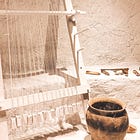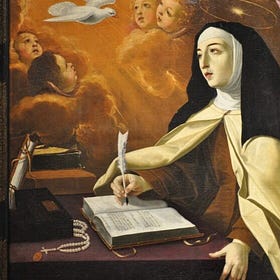My Grandmother Carmen, Star of the Sea
On dementia, orienting toward the Stella Maris, and the consolation that comes from braiding my life to the Living Soul
Listen via audio
When she speaks I hear a piano. Single keys. Minor notes. Bass clef.
I hear whale song stretching time.
I hear longing. Desperate, and lonely.
If the earth reaching for the setting sun had a sound, it would be the words under her words. Pulling desperately for some semblance of safety. Some reassurance. Mundane questions about whether there is enough money to pay her carer so we don’t have to go out of pocket; why we don’t divide up her valuables now in case they’re stolen; who will keep her house… and she always, always, always asks how long I will be here, and when I will leave - who she will be left with.
The dissonant song of longing stirs under her questions. It is the roar of the sea in a seashell, its enormity contained. The echo of things she means but cannot say. A murmuration susurrating alongside her pounding questions, repeated like waves breaking on the shore.
When she gets stuck in this loop of repetition, she disintegrates like backwash. Nothing left of her splendour but foam.
Sometimes she comes back. And she’s here. In her fullness. Her eyes bright and awake. And the mist she lives in scatters, for a moment. Sometimes longer. And it’s me who forgets her as she is now. And for a time she is as she once was. The great matriarch and wordsmith and spellbinding storyteller; queen of her kingdom. Dignified and magnificent.
And as suddenly, as swiftly as her old regal self swoops in, she takes off; falling the way a pigeon does to take flight.
Birds can use this method of falling to gain altitude, particularly in the absence of strong winds. And there are no strong winds here. No life. It is the stillness of death. A death prolonged. The bardo of the Tibetan Buddhists.
One moment she is engaged and articulate, accurate in her descriptions of her childhood and the day she fell in love with my grandfather. And then, without warning she falls, and folds back into herself.
From eagle to pigeon.
I watch the mists descend and take her away again. She becomes a traveler in the Arthurian legends, taken to the Otherworld by the fae against her will - where years pass in a single day, and where she may remain lost forever to the mortal realm.
Sometimes - more rarely because even through this, she is a hard woman - she goes into despair. And I think of Hafez:
I wish I could show you
when you are lonely or in darkness
the astonishing light
of your own being.
One night she woke up screaming for help. “I need to get home!” She pleaded. “They will be waiting for me! They will be wondering where I am!”
The last time I was here was about 18 months ago. I’m writing to you today from the same café. That day, I wrote:
I catch myself wanting to check out sometimes. My mind escaping to more pleasant things - thoughts of future plans or memories of laughter and summer swims or my beloved’s kisses. And it takes everything to bring myself back. To be present with her. To offer her the only thing I can give her now: my undivided attention. As Simone Weill would say, attention is the ultimate form of generosity. And absolutely unmixed attention is prayer.1
Perhaps this is religious. There is really no need for a church when you have a loved one who is forgetting. Our devoutness is not demonstrated by our presence in man-made structures and empty rituals, but in how we show up at the feet of our loved ones when they suffer. This is serving at the temple of the gods.
Here is the full essay:
She keeps asking to die. She wants the poison her mother used to give her cattle to put them out of their misery when they were elderly or sick.
According to Roman sources, particularly Strabo and Pliny the Elder, the women of pre-Roman Cantabria (here in northern Spain) were known for their fierce independence and spiritual strength. When old age came or capture by enemies seemed near, they would drink a poison made from the yew tree (taxus baccata) - a sacred tree to the Celts - to choose death on their own terms.
You can listen to this short story on the Celtic-Iberian women here:
This act was seen not as despair but as an expression of agency and ancestral dignity. I think it reflects a worldview where death was part of the natural cycle and the forest itself offered the means of crossing the threshold.
Sometimes it is all too much. It was all too much 18 months ago; and it was all too much seven years ago when the mists first started coming down on her.
The apprenticeship is to devotion. How to keep pouring from a cracked cup.
When I ask how she is, she either says, ‘like a stone falling down a well,’ ‘like a plant’, or ‘like a dog; I eat, I sleep, and I’m taken for a walk.’ And she laughs.
That’s one thing she hasn’t lost. Her sense of humour and her poetry. My grandmother speaks in metaphor and jest.
Still, her tragicomedy stings.
And the sound of her longing stretches in me. It lives somewhere in my chest now. Wrapped around my heart like mistletoe stifling a poplar tree.
Her illness is a net cast out, trapping all who enter her seas. No wonder no one comes to see her anymore. I can’t blame my cousins for their absence.
We are salmon squirming.
I find accompaniment in my faith in the Living Soul. The aliveness of the soul of the world. Though sometimes (often!) I waver in my convictions, I apply myself to rise out of my small self and into the greater living whole.
The concept of the anima mundi, or the "Living Soul”, traces its roots to ancient philosophical and mystical traditions. It symbolises the living spirit that permeates all of existence. In this view, the cosmos is not a mere mechanical system but a living, breathing organism imbued with consciousness. Within this framework, the anima mundi connects all beings and elements. It fosters a deep, interconnected web of life where every entity is a reflection of the whole.
Within the Hermetic and Neoplatonic frameworks, the anima mundi is seen as the bridge between the material world and the divine, a universal intelligence that sustains, guides and harmonises the forces of nature. The idea suggests that each individual soul (though distinct), is an expression of this greater, collective spirit. And the journey of the soul is one of awakening to the unity that underlies all of creation. This concept offers a vision of a living, conscious universe.
When I branch out of my personal sorrow and cast myself outward, I can feel it thrumming somewhere just beyond the confines of this grief. And I can feel myself a part of that luminous tapestry that holds everything together.
More often than not, my reminder of this ultimate reality isn’t gentle. It wallops me. It is deliberate, prompt, and effective. If it had a form, I would say she’s Mary Poppins chanting "spit-spot" when she's instructing the children to clean up their room.
"Spit-spot, tidying up, now! We haven’t got all day."
Whenever I can, I take refuge at a thirteenth-century crypt by the sea that I have gone to for years. Now you have to pay a 1 euro entry fee. But I pretend to be Catholic and they let me in. I shrug off the horror in having to choose between being religious or a tourist and the constant reminder that there are few places in this world outside New Age cacao ceremonies or full moon “goddess” circles for people like me.
The other day as I was walking out, I happened to look up and saw, blazing in the stone, the eight-pointed Star of Venus, or the Star of Ishtar. It persistently captured my attention in St Teresa de Avila’s convent when I was there last week. I noticed it was carved into stone, wooden beams, and painted on the main emblem of the Carmelite order which Teresa belonged to. You can read more on her in my latest Essay Series on mystics here:
The eight-pointed star is an ancient and resonant symbol. It reaches across cultures and centuries to represent renewal, cosmic balance, and spiritual illumination. In Mesopotamia, it signified the goddess Inanna, embodying celestial harmony and the cycles of Venus. In Egypt, it crowned Seshat, the goddess of wisdom, and symbolised divine order and cosmic knowledge. Islamic art reveres it as the "Rub el Hizb," expressing balance and the union of earthly and heavenly realms, while Christian tradition sees it as a beacon of resurrection and eternal life.

In medieval alchemy, the eight-pointed star became a potent emblem of transformation. It represented the alchemical marriage - the sacred union of opposites such as spirit and matter, masculine and feminine, light and shadow. Alchemists viewed this star as an image of regeneration symbolising the profound inner processes required for spiritual rebirth, and the quest to refine the soul into its purest essence.
Notably, despite the widespread suspicion and demonisation of many ancient symbols during the European Inquisition, the eight-pointed star was never widely cast as sinister or demonic. Its respected associations with renewal, redemption and divine harmony shielded it from negative reinterpretation, allowing it to remain a powerful and positive symbol through turbulent historical eras. Across ancient cultures, from Mesopotamia to alchemical manuscripts, the eight-pointed star consistently emerges as a profound emblem guiding us gently through our labyrinthine journeys of change and renewal.
I have since learned that as well as holding special resonance within the Carmelite tradition of St Teresa, the eight-pointed star is often associated with the guiding light of the Virgin of Mount Carmel, or the Virgen del Carmen! Carmen is my grandmother’s name. And the Virgen del Carmen is the patron saint of sailors here. The protector of all who face dangers out at sea. The North Star.
Star of the Mother, Star of the Sea, Stella Maris; the very essence of Teresian mysticism: the soul, like a star, draws steadily toward its source of light.
In moments of despair, I reach for that star.








A beautiful piece written straight from your courageous heart. Thank you for your compassion and love.
I adore the honesty and metaphors that sing bright through this piece Gabriela. Mistletoe or not, it sounds like her beautiful roots and branches reach up, up to starlight.